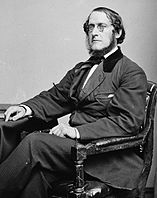United States House of Representatives elections, 1864
|
|
|||||||||||||||||||||||||||||||||
|---|---|---|---|---|---|---|---|---|---|---|---|---|---|---|---|---|---|---|---|---|---|---|---|---|---|---|---|---|---|---|---|---|---|
|
|||||||||||||||||||||||||||||||||
|
All 193 seats to the United States House of Representatives 97 seats were needed for a majority |
|||||||||||||||||||||||||||||||||
|
|||||||||||||||||||||||||||||||||
|
|||||||||||||||||||||||||||||||||
Schuyler Colfax
Republican Party (United States)
Elections to the United States House of Representatives were held in 1864 to elect Representatives to the 39th United States Congress. The election coincided with the presidential election of 1864, in which President Abraham Lincoln was re-elected.
In the midst of the American Civil War, the opposition Democrats were divided between the Copperheads, a group that demanded an immediate negotiated settlement with the Confederate States of America, and the War Democrats, who supported the war. The Democrats lacked a coherent message, and Lincoln's Republican Party gained 50 seats, increasing their majority over the Democrats. The National Union Party (formerly known as the Unionists) lost seven seats, retaining control of 18 seats (some classify the Representatives as including 13 Unconditional Unionists and five Unionists), all from the border states of Maryland, Tennessee, and Kentucky, as well as West Virginia.
One new seat was added for the new State of Nevada and 8 vacancies were filled by the readmission of Tennessee, the first secessionist state to be readmitted. Three former Confederate States held elections in 1865 that were rejected by Congress.
...
Wikipedia




